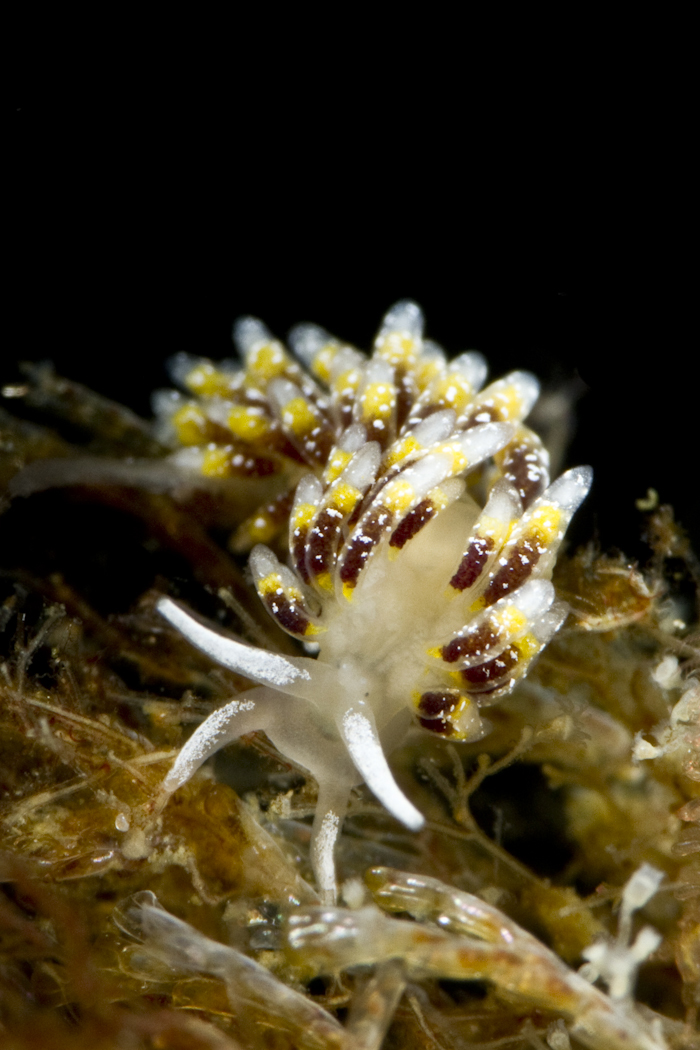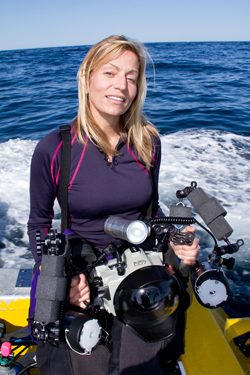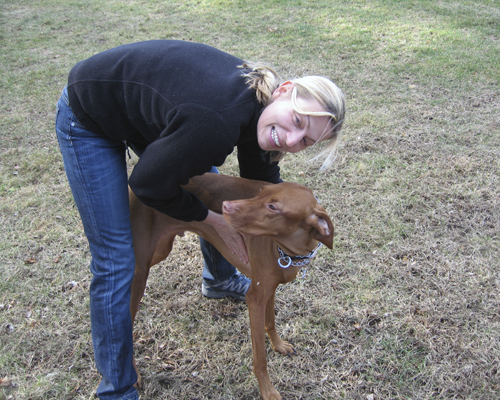 |
Cuthona fulgens
Photo courtesy of Allison Vitsky
Coronados Islands, San Diego, Calif
May. 2010
Copyright 2010
Cuthona fulgens (MacFarland, 1966)- An Argument Against Global Warming
We've got oil spills gumming up everything in the Gulf of Mexico, we've got volcanoes dumping 1000's of tons of Carbon Dioxide into the air, in numerous points on the globe. Makes you wonder if our oceans have a chance.
Many scientists are proponents of the Global Warming Theory, but an equal number question the data. This week's Branch of the Week (BOW) is one of thousands to species that are contributing to a growing database of information, suggesting that ocean waters are not warming, but in some areas where currents dominate, they may be cooling.
The long established range for the aeolid nudibranch, Cuthona fulgens, has been Kayostla Beach, Washington to San Luis Obispo County, California, where it has not been seen in years. Wham-bam, thanks to Allison Vitsky of San Diego, California, we now have several specimens showing up on the Coronados Islands, San Diego, California. Remember now that Point Conception is the boundary between the Oregonian faunal province to the north and the Californian faunal province to the south. A species jumping across this line and showing up far south of this geographic boundary is huge. Especially when the critter shows up off of San Diego, not just Santa Barbara, or Los Angeles. This is a leap people.
This tiny, but beautiful critter is one of many sea slugs who are finding cooler waters, farther south than previously, appealing. Interesting, at best.
Thanks Allison. Talk among yourselves.
Allison-
"...This picture was taken at Los Coronados, a set of three islands off the coast of northern Mexico. Most charter boats dive the shallow, calm sites of the northernmost island, which reliably yields reasonable conditions, lovely rocky structure, abundant garibaldi, and a playful population of sea lions. While I have seen several different species of nudibranchs at the sites of the northern island, the numbers and variety can be underwhelming. Braving the pinnacles off the middle island and kelp adjacent to the southern island is not always as easy and sometimes requires a dose of seasickness medication (on more than one occasion, we have looked down upon the kelp bed off the southern island and been forced to call a dive based on the horizontal positioning of the leaves, indicating a ripping current). However, when it’s good out there, it’s really good! A few weeks ago, diving one of our favorite sites, I saw a tiny Flabellina trilineata sitting prettily on a clump of hydroids, and I stopped to take a picture. However, when I looked closer, the other side of the hydroid clump was teeming with about 7 of these Cuthona fulgens . They were so tiny that I misidentified them as C. lagunae in the water, otherwise I'd have shot them the whole dive! Turns out, they have not been seen this far south before. I recently upgraded my camera to a Canon Eos 7D, which I submerged for the first time back in April. Since then, this setup has accompanied me on over 75 dives (Southern California/Northern Mexico, Florida, the Bahamas, and the Philippines). This is my second dSLR setup – I was previously shooting a Canon Eos 20D. I knew the 7D was going to be a step up for me, but I could not have anticipated how big a step! The Cuthona above was shot with a 100 mm macro lens and a Macro Mate (a strong external diopter that severely limits my working distance…but can give gorgeous results). While this combination was not always useable on surgy days with my previous setup, I have recently used it with success on dives with truly terrible surge. The autofocus on the Canon 7D is phenomenal – it is incredibly fast and uses 19 cross type sensors (as a point of reference: in the previous Canon cropped sensor camera, the 50D, there were 9 AF sensors, which operated as the more sensitive cross-type only with lenses of 5.6 or faster), allowing me to focus precisely, even when there is lots of movement in the water. As for low-light capabilities, well, I forgot to turn on my focus light one surgy, dark morning at La Jolla Shores, and I didn’t even notice until the end of the dive - I still managed to get “keeper” images of some small nudibranchs and an absolutely tiny amphipod from that dive. The 100% viewfinder makes it easy to see exactly how your subject will be framed in the resulting photo. And finally, the 7D also has dual processors, making quick work of the write time for the 22 MB raw files, and so far, I have seen a big improvement in image quality – especially sharpness, but also color. In short, this is the ultimate nudibranch shooter’s tool!! (Of course, if you’re a wide-angle aficionado, you’ll also notice that sunballs and sunrays are much more easily achieved than with previous Eos cameras…but maybe this information belongs on another website…) As if this weren’t enough, the 7D also has HD video capabilities. I have not explored this yet, though I do know how to turn the video setting on – I will try my hand at it soon!..."
Allison with Cannon 7D

|
|
Gig Harbor, Washington
Jun., 2010
Allison Vitsky
San Diego, Calif
Jun. 2010
WEBMASTER'S NOTES
I want one! Now what is my banker's number? All kidding aside, Allison's experience thus far with the 7D echos comments Pete Fowler of our club made some time ago and that is the rapid convergence of dSLR and video camcorder technology in the past year or so. Pretty soon they will probably be indistinguishable! And that is why I am very hestitant to respond to questions along the lines of what is the best prosumer HD camcorder to buy given the video capability of select dSLR's. Can't wait to see HD video from the 7D!
San Diego, CA
Jun., 2010
Allison at play with friend

|
I learned to dive in 1993, but I never had much interest in imaging until 2006, when I visited the Solomon Islands. The combined exposure to Indopacific marine life and some fantastic photographers on my trip inspired me, and I started taking a camera with me on every dive. A work move to San Diego in 2007 put me in an ideal position to pursue my obsession year-round (and surround myself with people of like mind). While I love traveling to places where I can dive without a drysuit, my favorite place to dive is the cold, green water of California. There is nothing like a murky, surgy dawn patrol dive to start your day off right! I just upgraded from a Canon 20D to a Canon 7D in a Subal housing with Sea and Sea YS250 strobes.
When not diving, I support my obsession with my day job as a veterinary pathologist.
Send Allison email at avitsky@msn.com |

|
